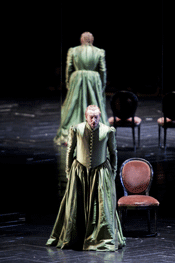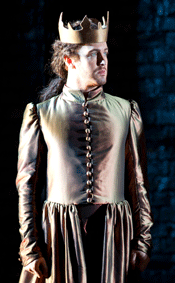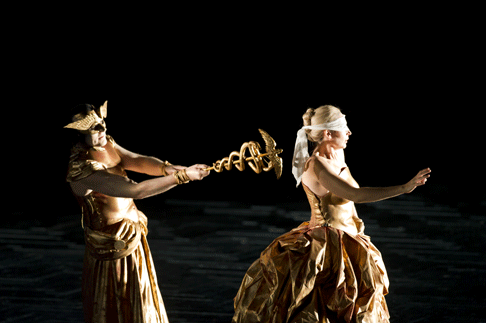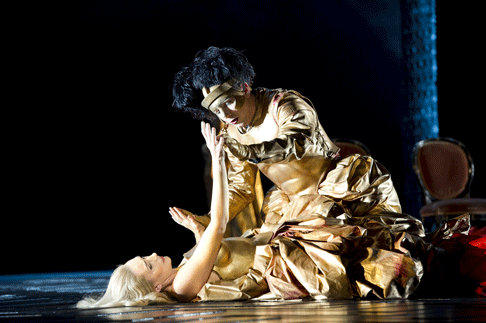So it was with some surprise that Niobe, Regina di Tebe by
Agostino Steffani (first performed 1688) hit the computer screen some months
ago as Covent Garden’s 2010/11 baroque offering. Many could be forgiven
for muttering “what…by whom?”
 Jacek Laszczkowski as Anfione
Jacek Laszczkowski as Anfione
Reading the ROH notes, it becomes clear that it was a combination of
financial expediency (a useful co-production with a recent successful track
record) and genuine appreciation of the music revealed in the 2008 revival at
the Schwetzingen Festival that encouraged the Royal Opera to add its
considerable clout to the 2010 revival performances around Europe. Leaving
aside the question of why Steffani — an admirable polymath of his time,
but hardly the baroque’s greatest opera composer — we must at least
be thankful that the ROH has been prepared to put some time and effort into
converting what was an essentially small scale festival production into
something that fits the bigger stage.
Even more important than this stage adaptation is the quality of the music
and story-telling: and for this we must thank the energetic and committed
Thomas Hengelbrock who as director of the period-instrument Balthazar-Neumann
Ensemble has been the driving force behind the production from 2008 with his
own critical edition. The same production team that enjoyed such success at
Schwetzingen are responsible for the “hard gloss & soft fabric”
look of the piece that on occasion seems to hark back to some of Pierre
Audi’s early works with the Monteverdi operas. Exaggerated richly-hued
baroque flounces and golden breast plates contrast with mirror surfaces and
monumental palatial interiors. There are some very effective visual ideas that
complement the richness of the scoring and the mythological elements of the
libretto — be prepared for costumed fanfares, huge helium balloons and
some very realistic fire effects — Steffani, with his taste for stage
machinery and loud bangs, would have approved.
 Tim Mead as Clearte
Tim Mead as Clearte
The story itself is a re-telling of the events leading up to the destruction
of the proud queen Niobe of Thebes as told by Ovid — a tale of love,
desire, pride and hubris that ends in tragedy – yet in true baroque fashion it
also confirms the ascendancy of love and honour. Niobe, soprano Veronique Gens,
is left to rule Thebes as her husband Anfione, male soprano Jacek Laszczkowski,
goes off on a sort of regal “retreat” — a bad move on his
part as Niobe has a would-be lover in the form of courtier Clearte,
countertenor Tim Mead, and another in the form of foreign prince Creonte,
countertenor Iestyn Davies. There is the almost-ubiquitous malevolent magician
of these times, Poliferno, bass Alastair Miles, plotting in the background. Add
to this the amorous sub-plot of two lesser characters, priestess Manto, soprano
Amanda Forsythe, the daughter of High Priest Tiresia, baritone Bruno Taddia,
and prince Tiberino, tenor Lothar Odinius, and season with a comic nurse
character Nerea, contralto Delphine Galou, and you have a baroque
compÙte to rival any of Handel’s or Vivaldi’s. Where it
differs is that here there is no lieto fine and the final scenes are a
chilling reminder of how the gods punish the proud and foolish. Dead children
are never an easy call for opera, and the emotional punches are not pulled. The
very final scene, sung by the newly-enthroned Creonte, is both sternly
optimistic but also ambiguous.
 Alastair Miles as Poliferno and VÈronique Gens as Niobe
Alastair Miles as Poliferno and VÈronique Gens as Niobe
The quality of the vocal writing matches the inventiveness of the music
which seems to hover, musicologically, somewhere between Cavalli and early
Handel. The recitatives are lyrical, the arias and duets constantly change form
and texture with no one vocal style predominating. There is no aria longer than
five minutes and the da capo form in its full Handelian sense is
missing: this helps to drive the action forward and several set-piece arias are
interrupted by another character. The orchestration is equally complex and
thoroughly fascinating in its detail and richness; often a character will be
assigned his or her “own” obbligato instrument – such as
the nurse Nerea who sings several slightly cynical or world-weary arias with
some virtuosic recorder playing echoing her complaints. Anfione is often
accompanied by the smaller strings and viola da gamba. Under the
confident and stylish direction of Hengelbrock, his expanded orchestra gives an
object lesson in how to transfer what was an intimate festival performance in
2008 into a major house display in 2010.
The singers themselves — also mainly from the Schwetzinger production
— sound and look comfortable in their music. Niobe is a perfect role for
the statuesque figure and warmly lyrical soprano of Gens; she convinced totally
as her voice moved from purring eroticism to agonised despair. Her husband
Anfione, the reluctant king, was equally believable in the hands and voice of
Laszczkowski whose male soprano worked best when he stopped the action with
heartfelt prayers for harmony, love and a bit of peace and quiet. Occasional
tenorial lapses were a slight problem at the bottom of his soprano range, but
there is no denying the ethereal effect of his top. Of the countertenors,
Iestyn Davies had the least to do vocally, but did it best. He continues to
mature vocally and dramatically and his voice is an effective mix of clarity,
volume and pleasing tone. Tim Mead perhaps gave more on the acting front and
was a convincing besotted lover. Alastair Miles, who makes something of a habit
of playing evil magicians, was nicely devious with his reliable bass as agile
as ever. Is there a better baroque Mr Nasty? Delphine Galou (Nerea), Amanda
Forsythe (Manto), Bruno Taddia (Tiresia) and Lothar Odinius (Tiberino) all
pleased without quite approaching the levels of the principals; Forsythe has a
pretty, light, soprano that struggled in the large space whilst Galou’s
lightish contralto carried more easily to the back of the house.
 VÈronique Gens as Niobe and Iestyn Davies as Creonte
VÈronique Gens as Niobe and Iestyn Davies as Creonte
Although there was not, unsurprisingly, a full house on first night, there
was a noticeable lack of empty seats after the one interval, which is always a
good sign with a “new” opera. Most of the audience seemed caught up
with the excellence of the music and visual spectacle and were generous in
their applause at curtain call. If Gens and Davies just about won the
applause-stakes for the singers, then they were both beaten by a short head by
the superb players of the Balthasar Neumann Ensemble in the pit. Thomas
Hengelbrock looked both relieved and delighted, and so he should. The
production runs to the 3rd October before transferring to Luxembourg.
Recommended.
Sue Loder © 2010
image=http://www.operatoday.com/Gens_Niobe_ROH.gif
image_description=VËronique Gens as Niobe [Photo by Bill Cooper courtesy of the Royal Opera]
product=yes
product_title=Agostino Steffani: Niobe, Regina di Tebe
product_by=Niobe: VËronique Gens; Anfione: Jacek Laszczkowski; Manto: Amanda Forsythe; Creonte: Iestyn Davies; Tiberino: Lothar Odinius; Clearte: Tim Mead; Nerea: Delphine Galou; Tiresia: Bruno Taddia; Poliferno: Alastair Miles. Royal Opera House, London. September 23rd.
product_id=Above: VËronique Gens as Niobe
br/>All photos by Bill Cooper courtesy of the Royal Opera